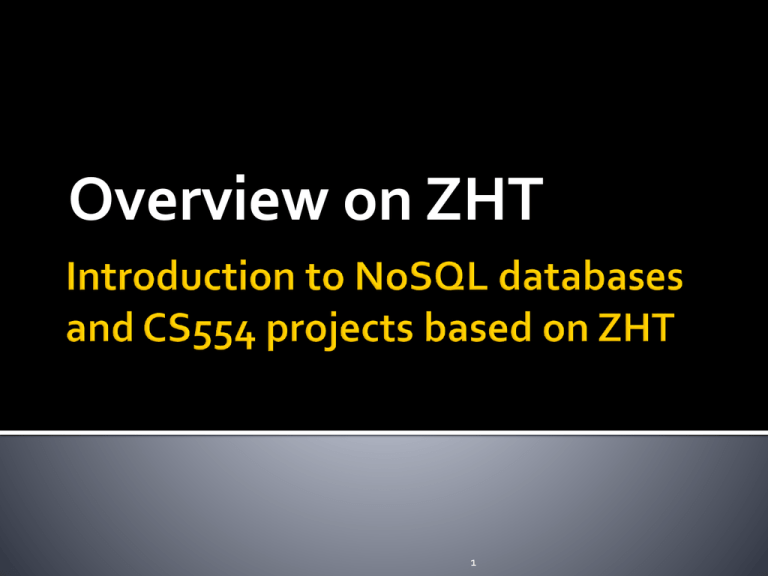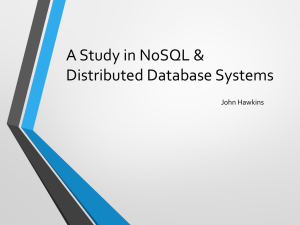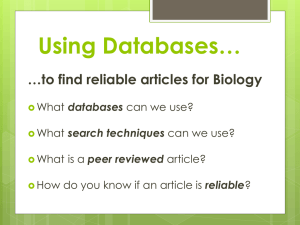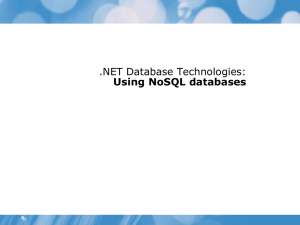ZHT - Data-Intensive Distributed Systems Laboratory
advertisement

Overview on ZHT 1 General terms Overview to NoSQL dabases and key-value stores Introduction to ZHT CS554 projects 2 Relational databases Query with SQL DB2, MySQL, Oracle, SQL Server CS 425, 525 NoSQL databses Loose consistency model Simpler design High performance Distributed design 3 Key-Value store ZHT, Dynamo, Memcached, Cassandra, Chord Document Oriented Databases MongoDB, Couchbase Graph databases Neo4J, Allegro, Virtuoso 4 Another name for Distributed Hash Table 5 Node Node Node n 1 2 Node n-1 ... Client 1 … n Key Key j k Value k Replica 3 Value k Replica 1 Value k Replica 2 hash hash Value j Replica 2 Value j Value j Replica Replica 1 3 6 7 Updating membership tables Planed nodes join and leave: strong consistency Nodes fail: eventual consistency Updating replicas Configurable Strong consistency: consistent, reliable Eventual consistency: fast, availability 8 Many DHTs: Chord, Kademlia, Pastry, Cassandra, C-MPI, Memcached, Dynamo ... Why another? Name Impl. Cassandra C-MPI Java C Dynamo Java Memcached ZHT C C++ Dynamic Append Routing Persistence membership Operation Time Log(N) Yes Yes No Log(N) No No No 0 to Yes Yes No Log(N) 0 No No No 0 to 2 Yes Yes Yes 9 ZHT Bench: Benchmarking mainstream NoSQL databases ZHT Cons: Eventual consistency support for ZHT ZHT DMHDFS: Distributed Metadata Management for the Hadoop File System ZHT Graph: Design and implement a graph database on ZHT ZHT OHT: Hierarchical Distributed Hash Tables ZHT ZST: Enhance ZHT through Range Queries and Iterators 10 IBM Blue Gene/P supercomputer Up to 8192 nodes 32768 instance deployed Commodity Cluster Up to 64 node Amazon EC2 M1.medium and Cc2.8xlarge 96 VMs, 768 ZHT instances deployed 11 Familiar with Linux and it’s command line Shell scripting language (eg. Bash, zsh…) Programming skills in C++/C (except benchmark) GCC compiler No object oriented skill needed 12 Goal: Extensively benchmarking NoSQL databases and analysis performance data. ZHT, MongoDB, Cassandra Neo4J (experiment for Graph) And others… Metrics Latency and its distribution , throughput Parameters Message size Scales Key Distributions 13 Goal 1: allow replicas serve read operation Goal 2: maintain eventual consistency between replicas Goal 3: make it scale (pretty hard!) Optional goal: allow replicas serve write requests and maintain consistency (applying Paxos protocol, even harder) 14 What is metadata? Goal: improve HDFS performance by adding distributed metadata service Requirement: experience with Hadoop and HDFS; strong programming skill in both Java 1000 and C++ Time Per Operation (ms) 100 Fusionfs 10 1 1 2 4 8 16 32 64 128 256 512 Number of Nodes 15 Goal: build a graph databases on top of ZHT How: construct a mapping from key-value store interface to graph interface 16 Goal: adding a proxy level to ZHT architecture so to reduce concurrency stress to each server Easy: make it work and scale Hard: handle failures 17 Goal: design and implement new interface methods to ZHT Iterator: next/previous operation Range get/put: given a range of key, return a series of results in one request loop How? Sorted map B+ tree (bold!) 18 Communication: come and talk to me (by appointment) Make good use of Google Fail quick, fail early, fail cheap. Fast iteration: very small but frequent progress Why bother? 80% points from projects! 19 Welcome abroad and enjoy! Tonglin Li tli13@hawk.iit.edu http://datasys.cs.iit.edu/projects/ZHT/ 20










